Category: Longform
You are viewing all posts from this category, beginning with the most recent.
Darwin Research Center
We started our day today with a visit to the Darwin Research Center. One of the main projects at this center is the preservation of the many different species of tortoises on the islands. Many of which were hunted to near extinction by whalers or pushed out of their habitat by goats, dogs and cats. The tortoise in the image below is a saddle back! A close genetic relative of “Lonesome George” that last true Saddleback that died a few years back. You can see that they have very long necks which is an adaptation for eating the cacti on the desert islands of the Galapagos.

And of course we saw many of the Galapagos Tortoise both at the Darwin center and later on in the wild.


Another highlight of the day was our chance to participate in Celebrity Cruise Lines reforestation project. Many of the native Escalesa trees were choked out by the blackberries that were imported by the settlers on the islands. With a lot of work the blackberries have been culled, but now Celebrity is working to replant many many acres of forrest with native Escalesa trees. To date Celebrity and their guests have planted nearly 40,000 trees, and I’m happy that we got to participate.
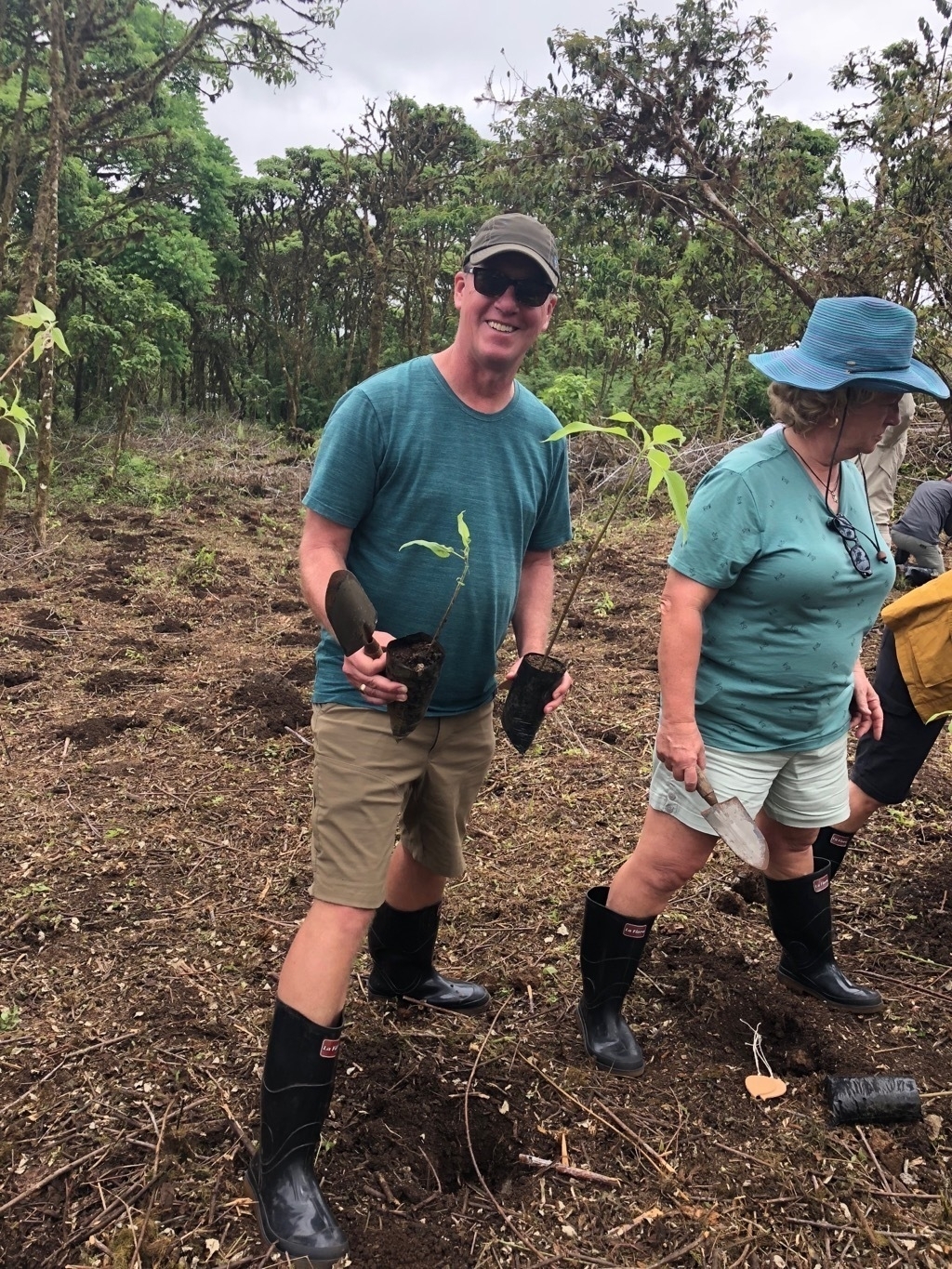
As an added bonus we all got to wear the super stylish rubber boots!
I 💙 Boobies
By this time of the trip the routine was well established. Breakfast in the morning, then off to the zodiacs for an adventure / hike on shore. Back to the ship for lunch and a rest during the worst heat of the day, then a late afternoon zodiac to another destination for another hike. This is definitely an adventure not a vacation! This afternoons hike was billed as the most difficult of the trip, because it involved a little rock scrabbling! As usual a few people joined that really shouldn’t have, you would think people would learn their limitations by this time. Anyway, after the rock scrabbling we were rewarded with a beautiful view of the beach.

Along the way we saw a lot of Blue Footed Boobies, we had to leave the trail to keep our distance from them several times as they just sit in the middle of the path looking at us. It was definitely worthwhile as this is probably one of my favorite photos of this whole adventure!
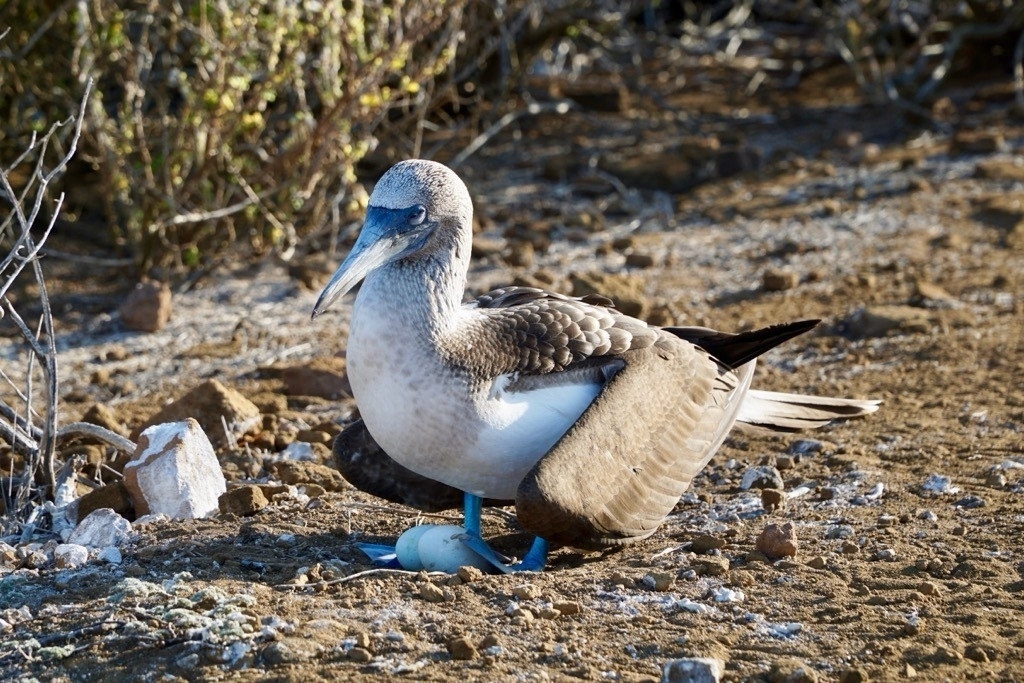
The blue footed boobies take turns on the nest, if you can call it that. It’s barely even a hole in the ground. Further, they don’t really even sit on the eggs, they kind of cradle them with their feet. Here’s a picture of the “changing of the guard”
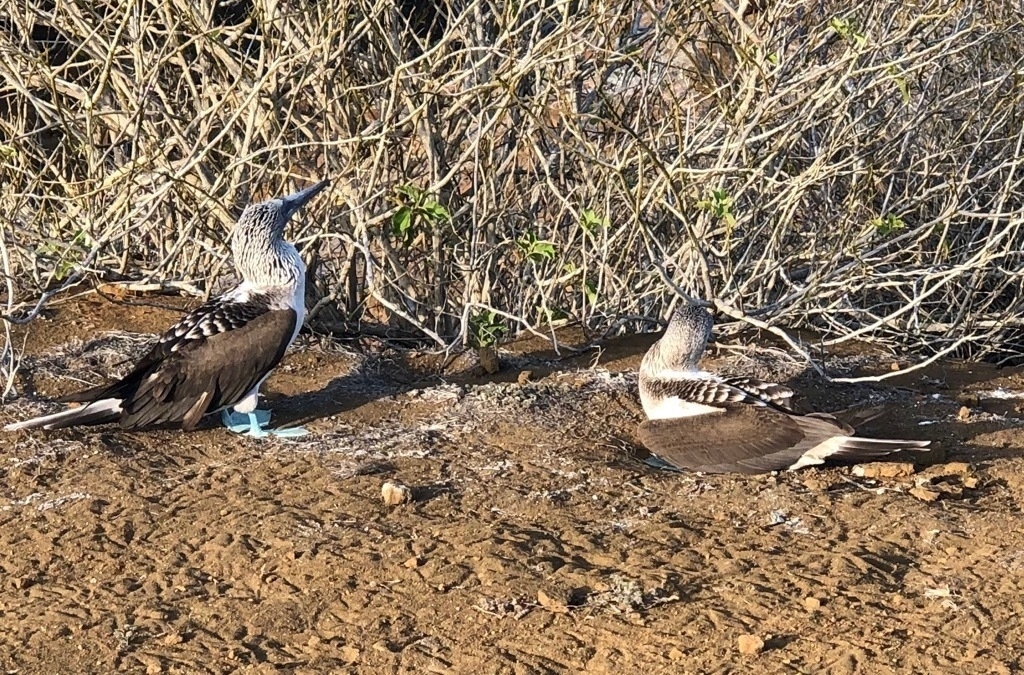
The reds are not nearly as interesting as the blues. They are arboreal and so you rarely see them on the ground. Their feet are red, but not bright red like the bright blue.

On the beach where we landed to start the hike was a small colony of sea lions.

Galápagos Day 4 — Santa Cruz
The activity of the morning was a “long” walk around Dragon hill on Santa Cruz. The main objective was to see the Land Iguanas. These creatures have been restored to the island after they were endangered by feral dogs and goats that humans brought to the island. Santa Cruz is one of the few islands that is actually inhabited.
The cover picture for this post is actually of a marine iguana that was near the shore by a brackish pool.

You can see a very clear difference in coloration and shape between the marine variety — which can swim using their tails for propulsion — and the land iguanas pictured below.
At one point they moved many of the Land Iguanas to an alternative island without any human habitation for them to come back, while they started a program to eradicate all of the goats and feral dogs. We actually saw a goat along the way, and the guides, who are also park rangers when they are on land, had to call it in so that the goat could be tracked down and captured.
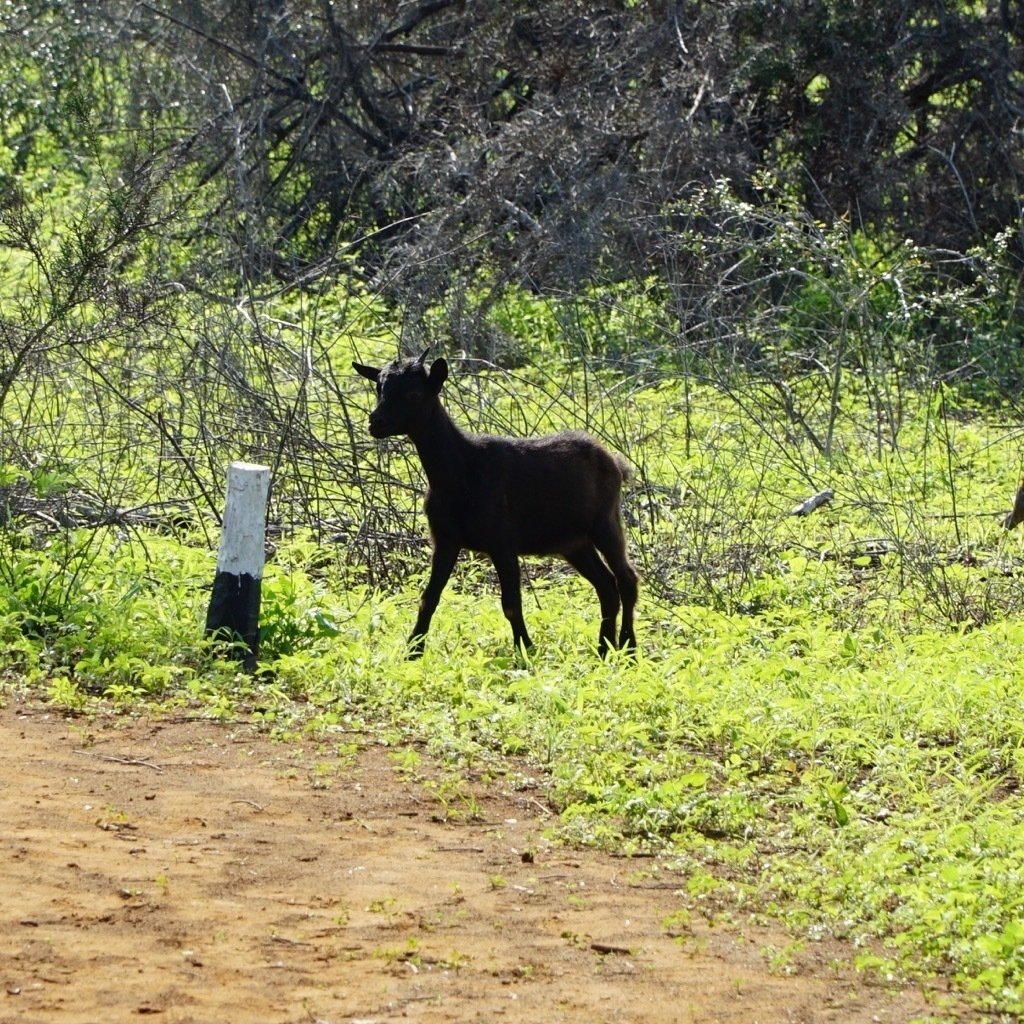
the walk started at 8:00 and already it was really hot. We began the walk on the beach and quickly passed by this beautiful brackish water pool.

The path was very muddy from rain the previous night, and a few people from the group ahead of us called it quits and headed back to the beach. But we kept going, eyes peeled for our first siteing. The first Land Iguana we met was pretty hard to miss as he was right on the trail!

Once we spotted the first one we started to see quite a few of them. Some close to the path, some sitting right outside their burrows, some “lounge lizards” hanging out on a log.



The scenery on the island was also very beautiful and couldn’t have been more different than our hike up the volcano from the day before.

Afternoon Snorkel
In the afternoon we had a beach snorkeling stop. The water was pretty wavy and as a result the visibility was not very good. I was right next to a big sea turtle and I could easily have grabbed onto the shell to go for a ride. But you don’t touch the wild animals so I just followed it and admired it s grace.
The real highlight of the snorkeling trip was the Pelicans. After coming back to shore there were about 3 brown pelicans that decided it was feeding time. They are “shallow plungers” so they swoop up into the air about 15 to 20 feet and then plunge awkwardly into the water to capture a fish! They were definitely not deterred by all of the humans in the water as several swooped right next to people! The pelicans were fine, but the people were a bit shocked!
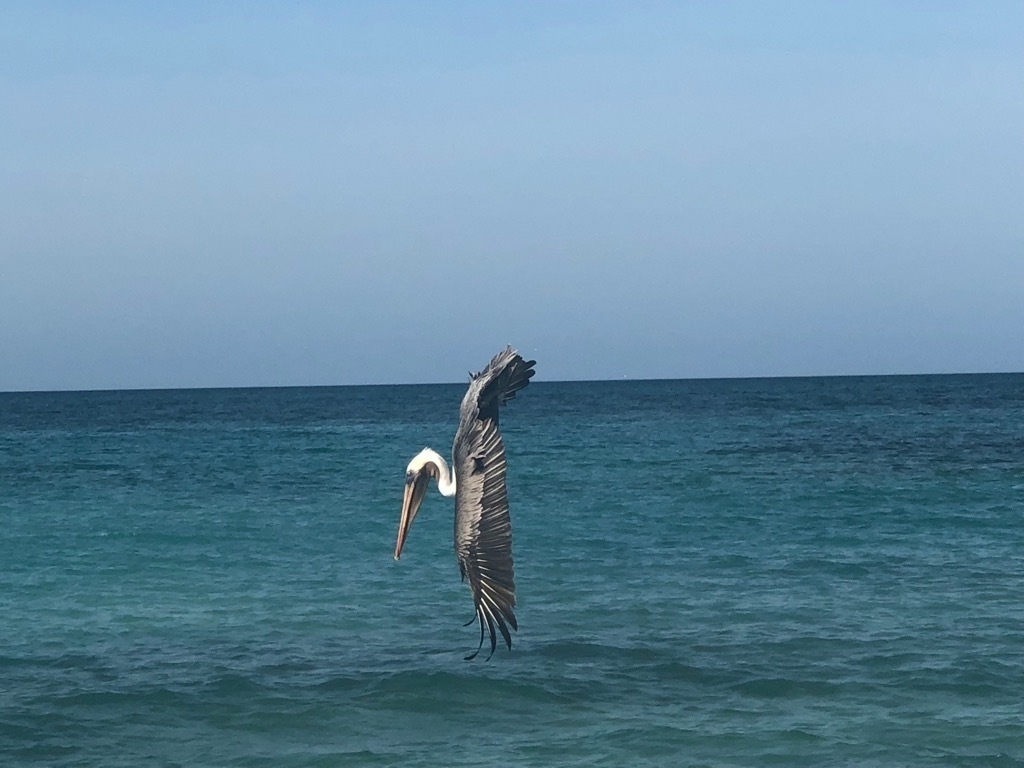
Galápagos Day 3 — Pinnacle Rock
If you google Galápagos Islands you will almost certainly see this picture:

You will likely see even better photos than the one above as we were there at the wrong time of day for optimal photo lighting.
The hike was mostly just climbing the 366 old wooden stairs and many boardwalks to the top of the volcano where there is a great viewing and picture taking spot. Along the way we stopped to learn a bit about volcanology, spatter cones, calderas, and craters.
The naturalists on board are all great and really knowledgeable. Most, if not all, of them were born on the islands and you can tell they all really love it.
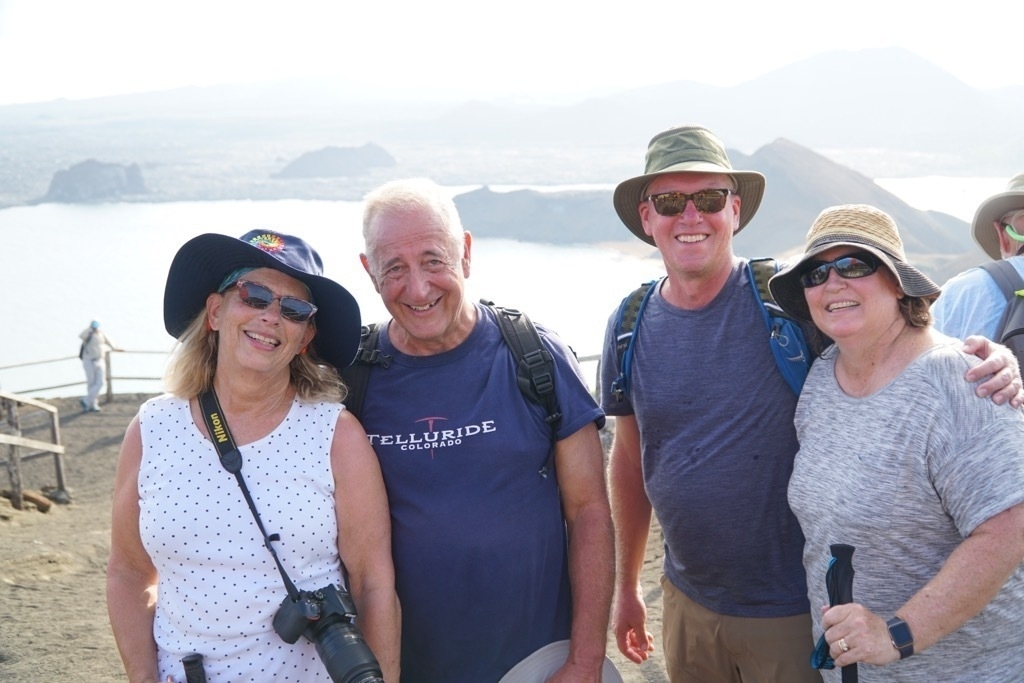
Galápagos Day 2
Looking out the window in the morning we couldn’t see anything. Had our luck changed? Were we going to have a rainy day after all? I went up on deck to investigate and was happy to see that it was just a dense fog. Caused by the cold water currents running up against the Galapagos ridge. It would burn off. All credit to Ann who insisted that we take the 10:00 excursion rather than the 8:00 excursion. This is what the fog looked like just before we boarded our zodiac at 10.
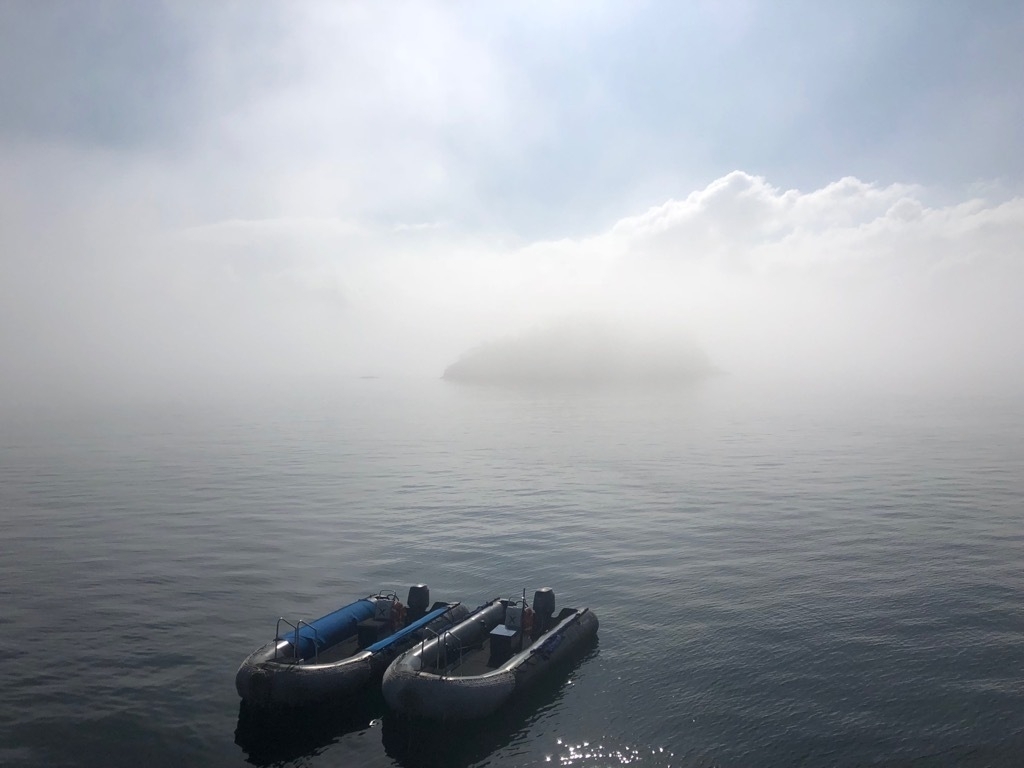
We later learned that it was so foggy during the 8:00 trip that one of the zodiacs took a wrong turn in all of the mangrove and got lost for a bit. Apparently everyone was taking it in stride and singing the theme song to Gillian’s island (except for one passenger who was not amused). I almost wish I was on that boat so I could tell the story in more detail. Here you can just barely make out our ship in the fog from a distance.
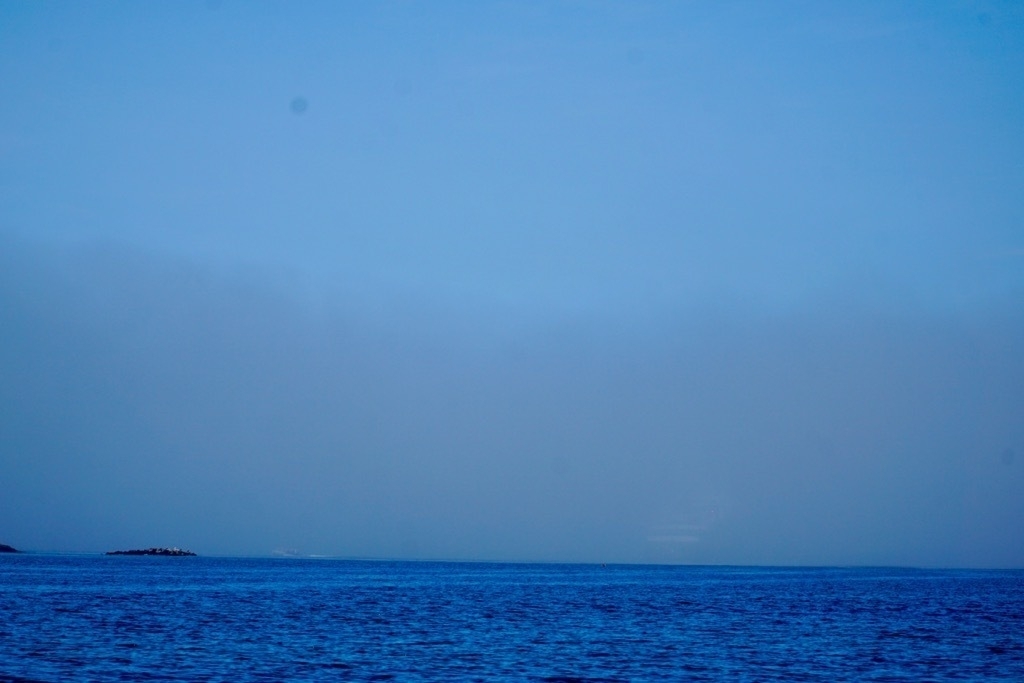
We were headed into a huge lagoon protected by mangroves but on the way we got some good sitings of a few of the marine birds. Below is the famous Blue Footed Boobie. Yes, I kind of giggle inside like a seventh grader every time I say that. The reality is that the name comes from the fact that they act like clowns during their mating dance. Kicking their legs up and flapping their wings and acting like fools.

We also got very close to a few brown pelicans.

And we saw the Galapagos Penguin! The second smallest penguin in the world.

They look kind of dopey and slow when they are out of the water but when they are in the water they swim fast and graceful.

We saw turtles all over the place poking their heads out of the water, but it was not until the afternoon when we did our deep water snorkel that we really got to have a great view of the turtles.

Toward the end of the trip we were way back amongst the mangroves and we saw a sea lion sleeping on a branch just a few feet above the water. We also had a very close encounter with a Great Blue Heron

We were also lucky enough to see some golden rays swimming just beneath us. Too bad that we were not able to capture them on camera.
Hike at Tagus Bay
The afternoon was in Tagus bay where we started with a drift snorkel. It was great, we saw a lot of sea turtles, and fish, but the most amazing was when I got to watch one of the penguins swimming underwater.
After we dried off from the snorkel trip we headed out for the “fitness hike” This was billed as a faster paced walk with fewer stops but the same great scenery. With people of all different ages on the cruise the walks tend to go at the pace of the slowest person in the group so we thought this would be a good option. And it was.

We climbed 150 stairs and then walked a bit to have a great view of the bay and this highly salty inland lake.
After a mile we came to the end of the trail where we could see the difference between the two sides of the volcano we were climbing. We were climbing the wet side and were suddenly treated to a huge vista of the dry side. You could images that you had just landed on mars!

We took another short zodiac ride to view the geology of the volcano and some of the wildlife. Here you can see the layers where the older layers have oxidized!

After we got back on the ship we had time to relax with a happy hour drink and enjoy the amazing sunset.

Up next was a delicious dinner where we watched one of our exhausted fellow passengers fall asleep right at her table with conversation and laughter going on all around her.
After dinner there was a small party to celebrate crossing the equator on our way around the north end of Isabella island. We were all encouraged to do the limbo and imitate one of our favorite Galapagos animals. As a group we did the blue footed boobie dance, and narrowly lost the contest to a couple imitating sea lions.
Galápagos Islands!!
Iguanas fighting over territory, thousands of crabs, two species of sea lions, lizards galore, birds and even a snake; this is what we saw on our first day in the Galápagos!
Today was a good practice day as we all learned about “wet landings” and “dry landings” in the Zodiacs we use to transfer from the ship to the shore. We go in groups of up to sixteen people along with a naturalist that will take us on our hike once on shore. It’s a bit of a process this first day to get off the zodiac in the water, then change shoes in the hot sand, but we are getting the hang of it.
We hiked for about 90 minutes and saw a lot of amazing animals…

When we first came ashore, we saw this baby sea lion just hanging out on the rock. Very cute.

The next thing we noticed was the lizards. They were everywhere and you had to be careful as you were walking so that you didn’t step on them! They are cold blooded so at this time of the morning they were all out on the warm sand bringing up their body temperatures.
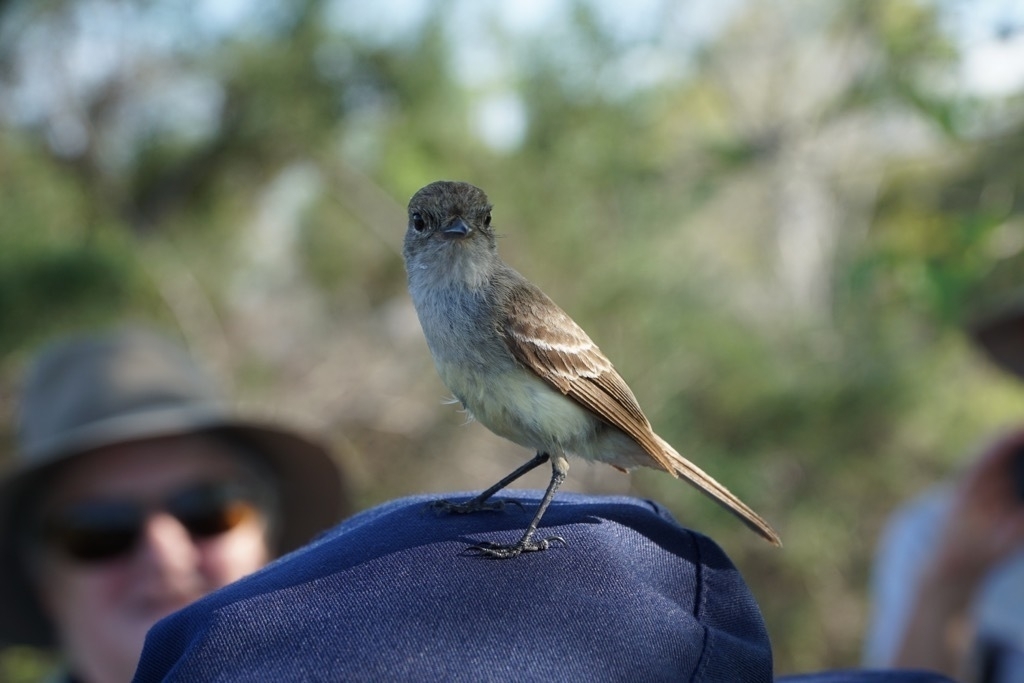
Of course the Galapagos are home to many many birds, and they have no fear of humans, very few of the animals on the islands do! But this one takes the cake as it landed on Ann’s hat. The guide told us that they really like cameras with big lenses and that they will use them like a mirror to admire themselves.

After hiking the inland part of the trail we started to walk the shoreline. Our first site was the sealions. They are nocturnal, so they were just floating in the cool waters and resting during the day. Looks like a pretty good life to me.

The shoreline was just full of these red crabs, called “sally light foot crabs”. Here you can also see one of the many iguanas looking at them. The iguanas eat algae so its not hunting them. The Oyster catcher birds, do hunt the crabs, and we saw some of those as well.

And here is the king of the iguanas! Looks like he is in charge to me!
Rabida Island

In the afternoon we headed to Rabida island for some more hiking and snorkeling. Here we are in all of our orange splendor.
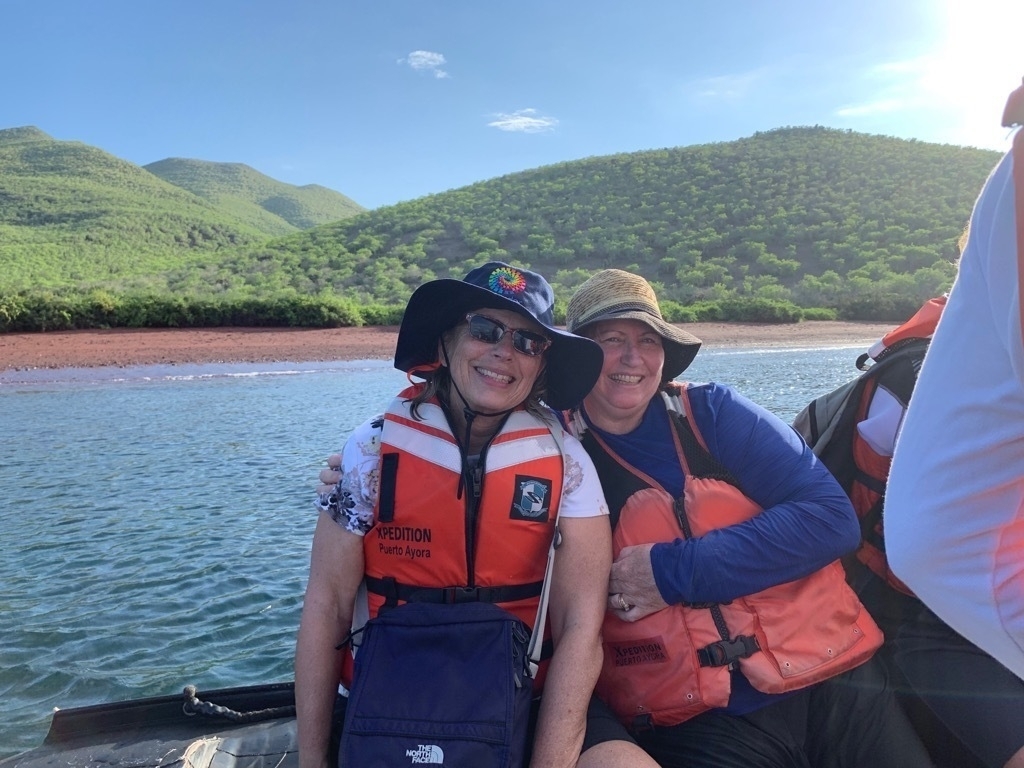
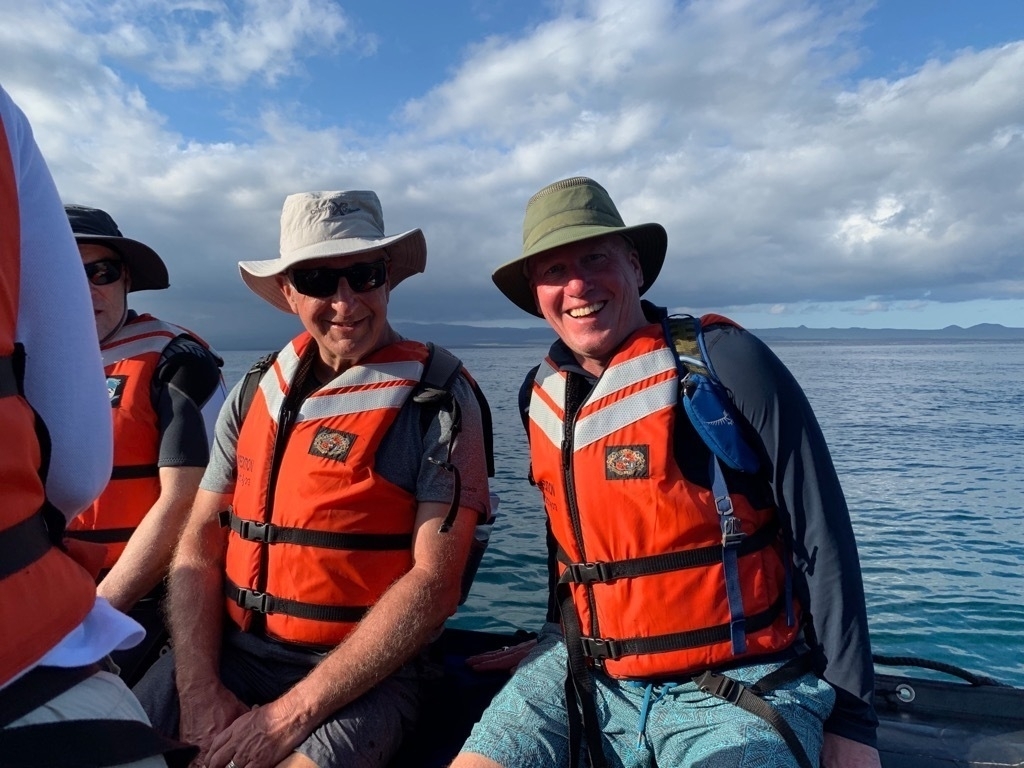
The hike was hot but really beautiful.

I just loved how the prickly pear cacti just grow right out of the lava rock on this island.

This is a brackish lake. Much of the water comes from rain and runoff from the hill behind, but at high tide, some water can flow over the mangrove berm and into the lake as well.

And this is the frigate bird. They are amazing in that they steal food from other birds right out of the air! They also love to float and glide alongside and above the ship as we slowly reposition ourselves.
At the Equator
It turns out that Ecuador is a great place to study the equator. It’s not in the middle of a jungle, but runs close to Quito with lots of varying terrain. They thought that they had the equator nailed, but then along came GPS and they found out there were off by about 200 meters. Now at the new and improved site we got to explore some of the common, cool things you hear about our hemispheres.
We did the water test. Yes, when the sink is directly on the equator the water goes straight down the drain. Moving it ten feet to the south the water makes a vortex going clockwise. When you move the sink 10 feet to the north the water drains counterclockwise! This is supposed to demonstrate the Coriolis effect, but I’m skeptical (and so are lots of other folks) that the effect would really be that different just a few feet either side of the equator.
We balanced an egg on the head of a nail. It was a bit windy and tricky to get right, but in the end both Jane and I accomplished the task.
We saw the sundial telling us the “true time”. It was about 20 minutes off from my watch.
And we did a strength test. This seems to be the most controversial and unexplained of all of the equator tests we did. Standing a few feet off the equator you can resist quite well someone pulling down on your arms. But standing directly on the equator line you seem to lose all your strength. Other than psychological explanations for this I haven’t found a physics based reason for why this is true.
In the moment it doesn’t matter whether any of these things are true or not, it was a good and fun way to spend our afternoon.
Cusco Cooking!
After a morning with Chef Jose you will definitely believe that Peru is the center of the culinary universe, and has been for thousands of years. Did you know…
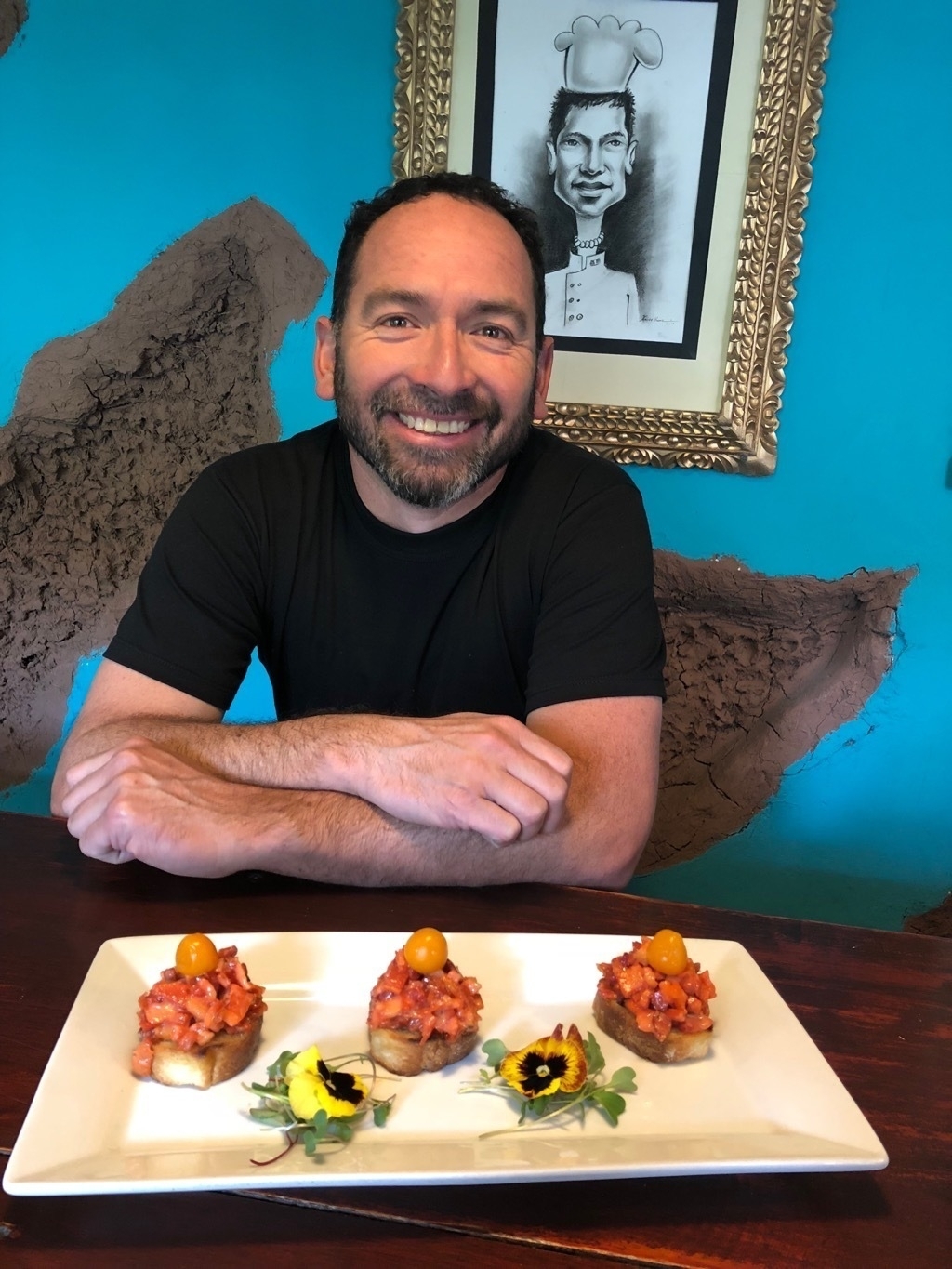
-
All tomatoes in the world originated in Peru?
-
All potatoes in the world originated in Peru?
-
Peru has been the top culinary destination in the world for several years running?
-
There are thousands of varieties of potatoes?
-
There are at least 3 different varieties of passion fruit?
Chef Jose picked us up at our hotel, and walked us the few blocks to his restaurant/culinary school. We started out with a fruit quiz. We actually got the first 4 of nine correct. Jose said we did way better than most.
After the quiz we tasted each of the fruits. Yes, me, I tasted all of them. Truthfully I liked most of them, except the one that looked and had the same texture as an avocado! The quiz didn’t include any banana or plantain as I had already told the chef I couldn’t eat them.
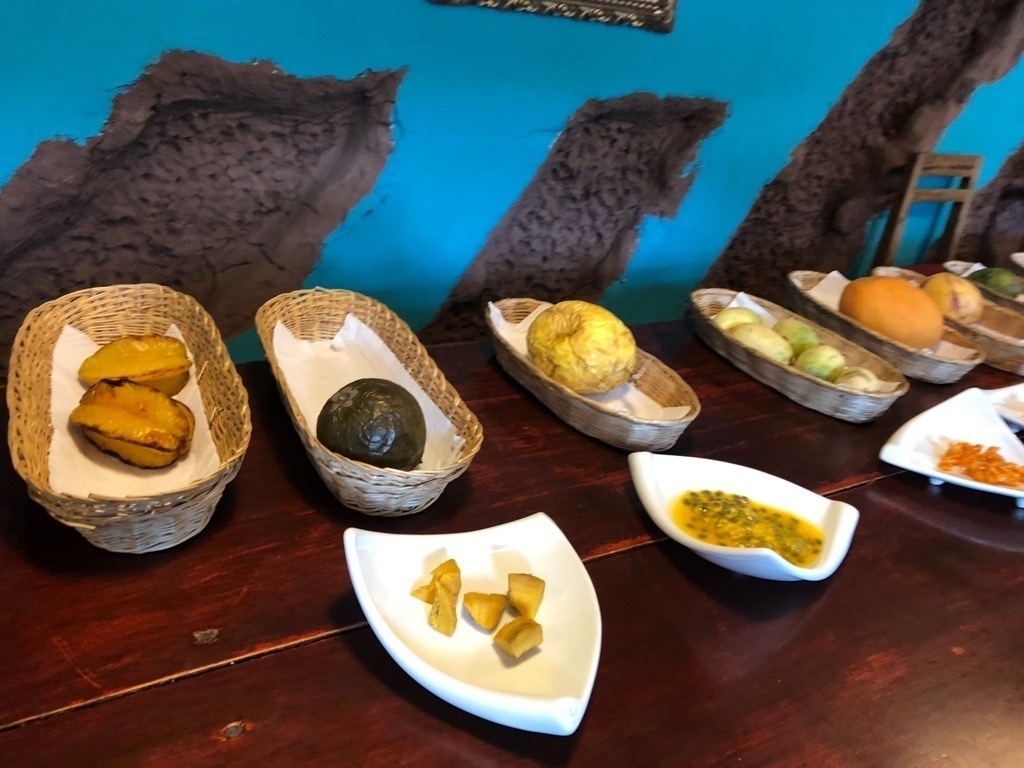
In the meantime, every few minutes someone would come in with a new appetizer for us to taste. Crunchy bruschetta and shrimp with Peruvian cheese melted on top. Delicious.
After the fruit tasting we went into the next room where we were introduced to many different ingredients used in Peruvian cooking. We learned about many different types of Quinoa, which has become so popular around the world that Peruvians have had to look for alternatives because its become so expensive in Peru!
Next up was a bit of mixology. We learned how to make the traditional Pisco Sour and another drink called a Chilcano. It was too sweet for both of us, so we decided to stick with the Pisco Sour. Which we took with us into the kitchen where we started on our first dish of the day. Ceviche — “Made with Love”. We learned not to trust any ceviche that is made and allowed to sit more than a few minutes before serving. Of course this means you need to make certain that your fish is absolutely fresh and perfect before you start.
Our ceviche was served with crunchy corn kernels and small cubes of sweet potato. Peruvian chefs love to play with combinations of flavors and textures and this combination definitely allowed for that! It was great, sweet potatoes are even tolerable if you have enough ceviche sauce on them!

After enjoying our ceviche and a little of our Pisco Sour we moved on to our second dish. A classic in Peru, called Lomo Saltado. It combines the wok cooking that influenced Peruvian chefs years ago with crunchy French fries and the rice that is so prevalent in Peruvian cooking. Like many Asian dishes this one cooks very quickly in a very hot wok once you get everything prepped.
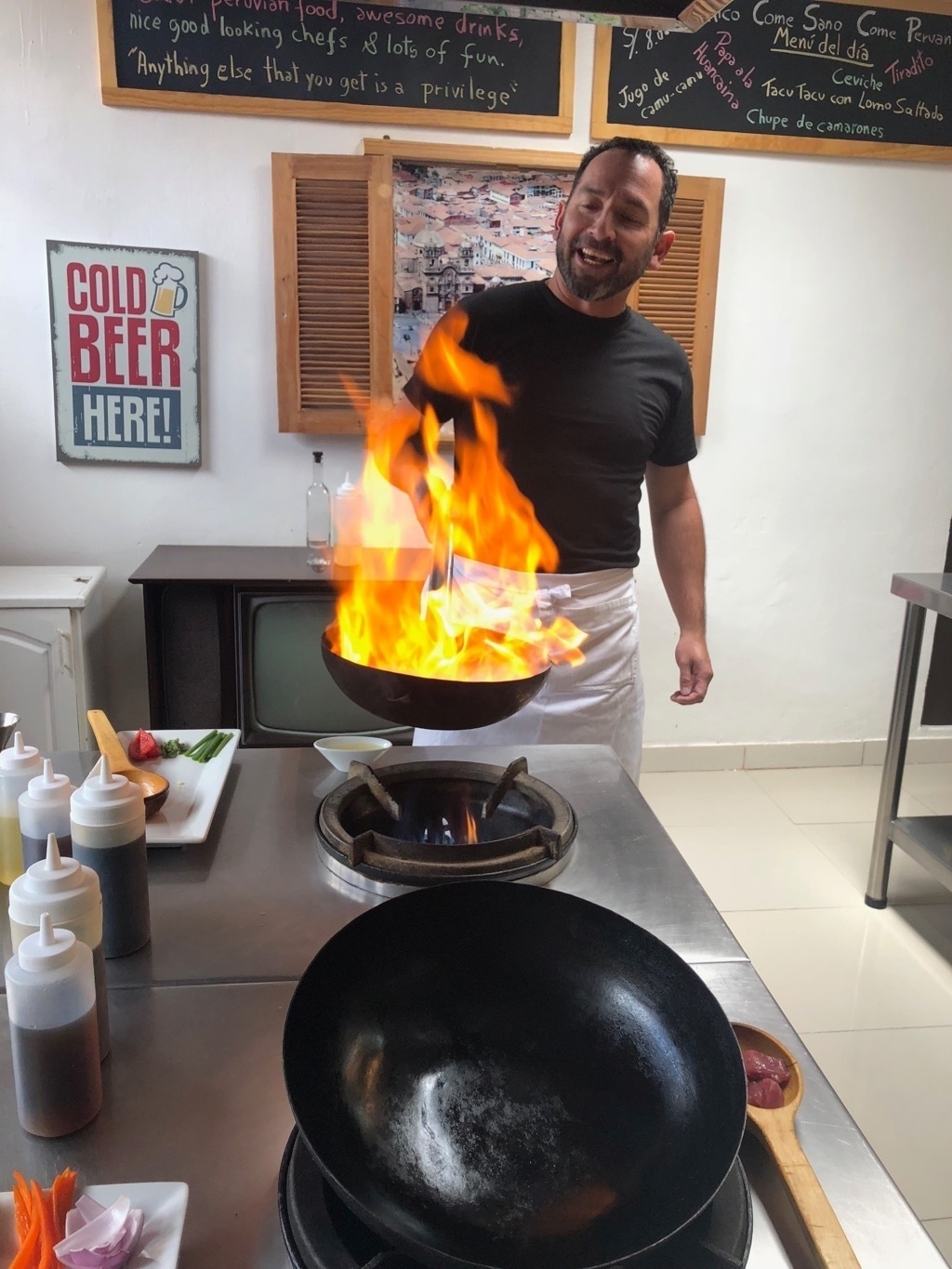
When we finished the dish we took it outside and ate it all under an umbrella along with our Pisco Sour drinks. It was great and definitely something I’ll try to replicate back home.
This was a great culinary experience and I would highly recommend it to anyone visiting Cusco and looking to learn a bit more about Peruvian history and culture through the food!
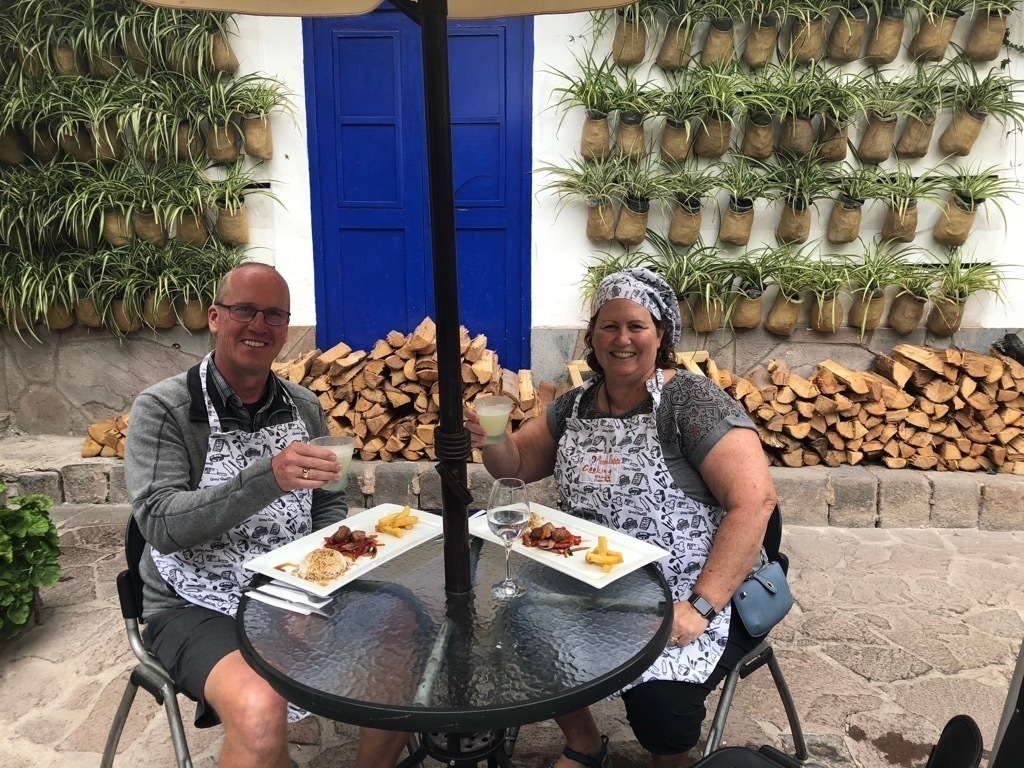
Saqsay Waman
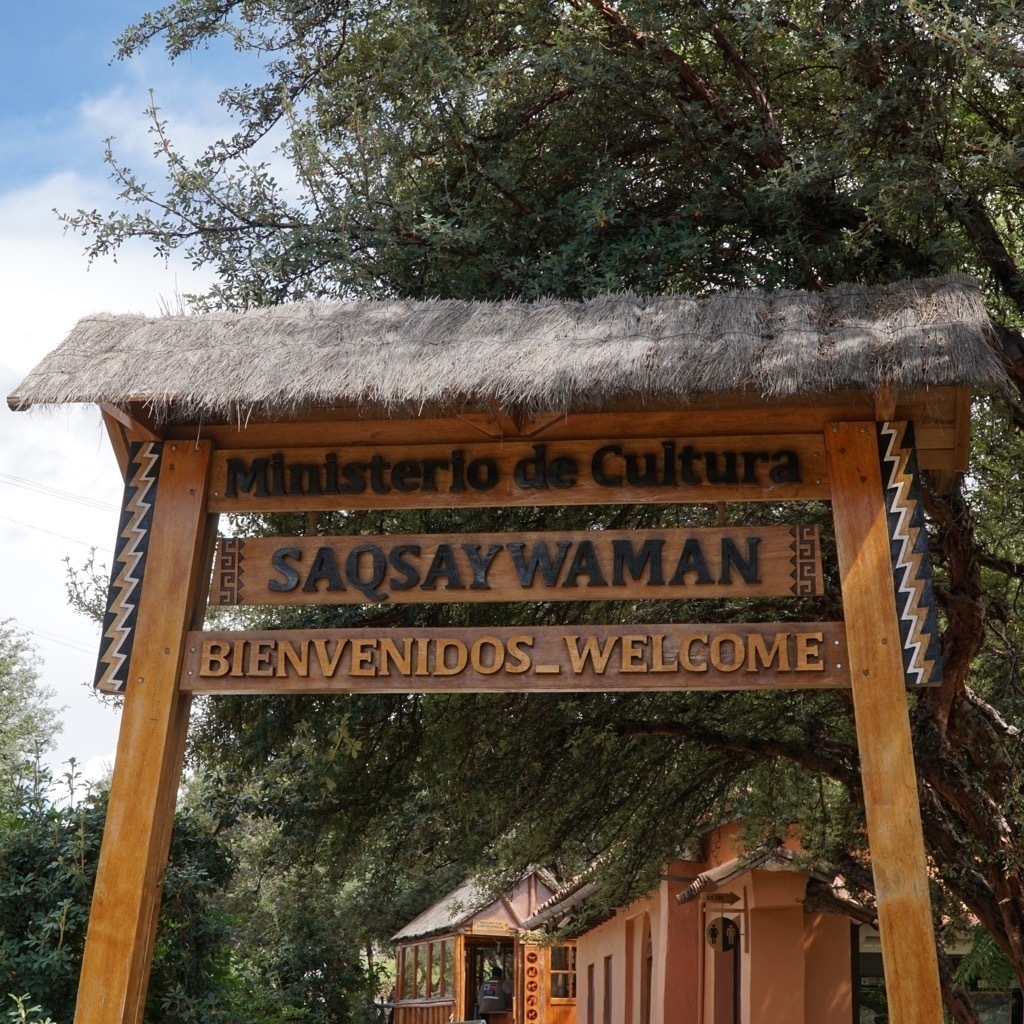
OK, if you say the above title out loud a few times you will know that I had to include that in this post. — Not getting it? Then think Sexy Woman. No, its not a risqué statue in the middle of Cusco it is another huge Incan structure on one of the many hills surrounding Cusco.
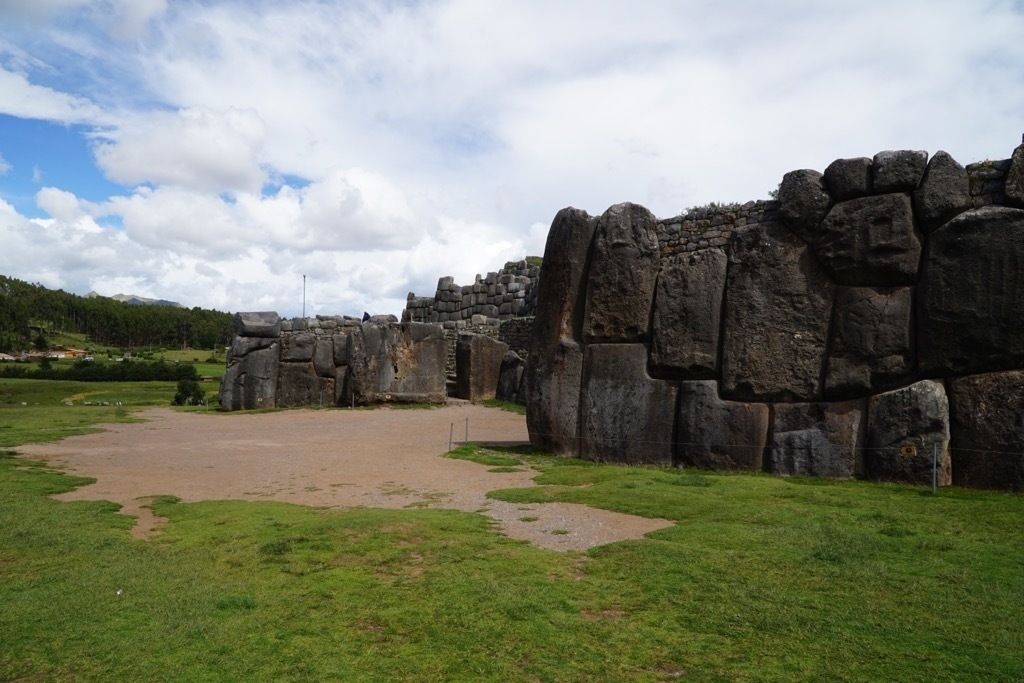
The walk around the Saqsay Waman site was also our first chance to get up close to a Llama (pronounced Yama by the locals)

Machu Picchu
It rained hard all night long, and it was still very cloudy when we got up for breakfast. But, by the time Fernando picked us up to go to the bus, the sun was shining and it looked like we were going to have great weather for our visit.
After seeing Machu Picchu from the Sun Gate I wasn’t sure what was left. Plenty, as it turns out. It was just amazing to walk with our guide through this huge complex and marvel at the design and engineering. For everything you see above ground there is also underground engineering work to create the drainage system that has kept Machu Picchu stable all of these years.

One of the biggest threats to Machu Picchu is the number of humans that visit each year. It wasn’t designed to handle that kind of traffic!

Machu Picchu was never finished, due to the Spanish invasion, but nevertheless many people lived there over the five generations it took to get it to what we see. During that time there was even much rebuilding as priests died and new priests took their place and wanted to change or move the various temples.
You can see several different levels of workmanship. From the super high quality at some of the lower layers and in the places where the important people lived to the lesser quality near the top as they rushed to finish, or simply didn’t care to do the same quality of workmanship for the new Spanish conquerors.
After a morning of wandering around, we had a delicious lunch at the restaurant right in the national park. Then headed down to Agua Caliente where it started to pour rain again. We hung out in the market for a while then headed to the hotel, where we met up with Bob and Bonni and sat by the fire until it was time to board our train to take us back to Cusco.
You never know who you will meet on the Inca Trail
I woke up around 3:30AM when I heard a few splatters of rain against the roof of our Casita. The alarm was set to go off at 5AM, groaning internally I rolled over and listened to the rain turn from splatters to a steady stream. Our goal for the day was to do the 7.5 mile Inca Trail hike to the Sun Gate of Machu Picchu. I really was not looking forward to doing that in the rain!
After much tossing and turning 5:00 finally came and we headed up for an early breakfast. We were meeting our guide and driver at 6:00 to head to the train for the trip to our drop off point. At breakfast we met Bob and Bonni who were taking the same train, but going all the way to Agua Caliente and visiting Machu Picchu from there.
When we arrived at the lobby to meet our guide, Bonni was on the phone with their guide. It seems that there was a big accident on the way from Cusco and that their driver was going to be at last 30 minutes late, which would cause them to miss the train. We volunteered to ask our guide to see if they could ride with us rather than riding in the taxi and everything worked out great.
About halfway to the drop off point the rain stopped! By the time we were ready to hit the trail we could actually see a few patches of blue sky peeking through the clouds. This was looking like a good day for hiking after all!

The one day hike has three main parts. The first half is up hill where we gained over 1500 feet of elevation. The next section is billed as being pretty flat, but that’s a lie. It’s flat until the end where you have to climb up to the Sun gate. From the Sun gate its all downhill, but that is maybe the last 1/8 of the 7.5 mile hike.
We took it at a good pace and enjoyed most of the climb. The scenery got better and better as we climbed higher. We were mostly alone on the trail. There was another pair of hikers that started just a bit before we did, and every so often we could catch sight of a larger group of 9 ahead of us on the trail.
Soon we were high enough to look down on the trains as they passed with passengers heading to Agua Caliente.

One of the sites we got to see along our hike was the amazing Wiñay Wayra terraces. It was beautiful to see from the distance.

We thought it looked close, but somehow we kept walking and it never seemed to get any closer. Finally we came down a few stairs then up a few stairs and stopped for a rest at the base of a waterfall. This was our time to gather our energy for the climb through Wiñay Wayra. When we arrived the group of nine was just leaving, so we felt like we were doing a good job of keeping the pace.
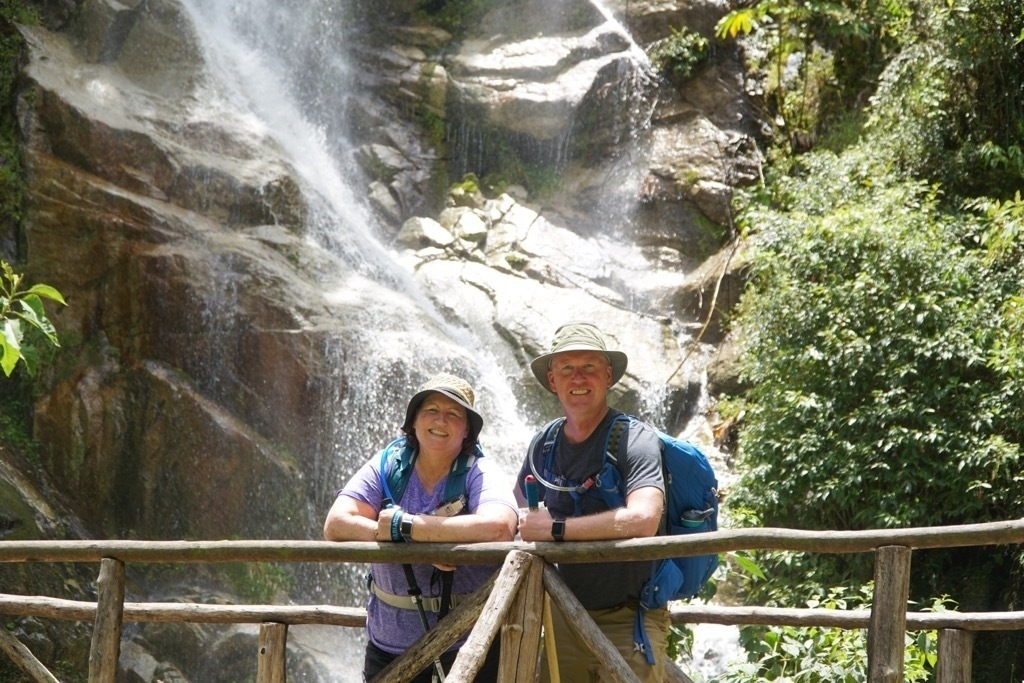
It looks a lot more daunting in person than it does in this photo. And when we finally got to the base I started counting stairs. We were able to do about 60 at a time then we would have to stop and rest and catch our breath.

The altitude definitely makes it harder work! After 375 stairs we finally arrived at the terrace about 2/3 of the way up where we were able to go across and exit. This was an amazing place for a picture.

This was basically the end of the uphill part. Both of us were extremely happy about that. The next couple of hours were pretty easy and we made good time. At some point along the way we even passed the larger group, saying our cheerful hellos as we passed.
The first big surprise of the afternoon came when I came around a corner and in the middle of the bridge ahead of me was a Spectacle Bear! It saw me and quickly headed the other direction, while I fumbled to try to unclip my camera. It moved off the path but Fernando advised us to just be quiet and wait. Soon we saw it again climbing across the limb of the tree.

Our guide had told us about the bear earlier, and we knew that it is one of two bears in the world that are vegetarian. He also said that this was only the second time in 25 years that he had seen one up close like this.
A bit further along we arrived at the first part of the trail where we started to climb toward the Sun Gate. Then we walked some more and came to the second part of the ascent, and then we arrived at the really hard part. You can get a good idea of how steep this was and a view of my best side.

We thought we would be there but we still had 10 more minutes of walking and another bunch of stairs yet! But when we finally got to the end it was so worth it! And we had the view all to ourselves.

After taking in the view, we moved off to the side where we could site on a nice ledge and have a snack and continue to enjoy the view. At this point the group of nine, that we had passed at some point during the day, came through the Sun Gate as well. We exchanged greetings and discovered that the group was from Minnesota and Iowa. This led to what part of Minnesota, what part of Iowa questions etc. When I said that we had recently moved to Minneapolis from Decorah, I heard a voice say “Brad!?” And this was the second big surprise of the day. Sure enough two of the People in this group were Kurt and Paula Meyer, fellow Luther alumnus and Paula had also been chair of the board of Regents when I served as faculty representative! Amazing!! Four Luther alums on the Inca Trail arriving at the Sun Gate within minutes of each other. What are the chances? Sounds like a data science question.
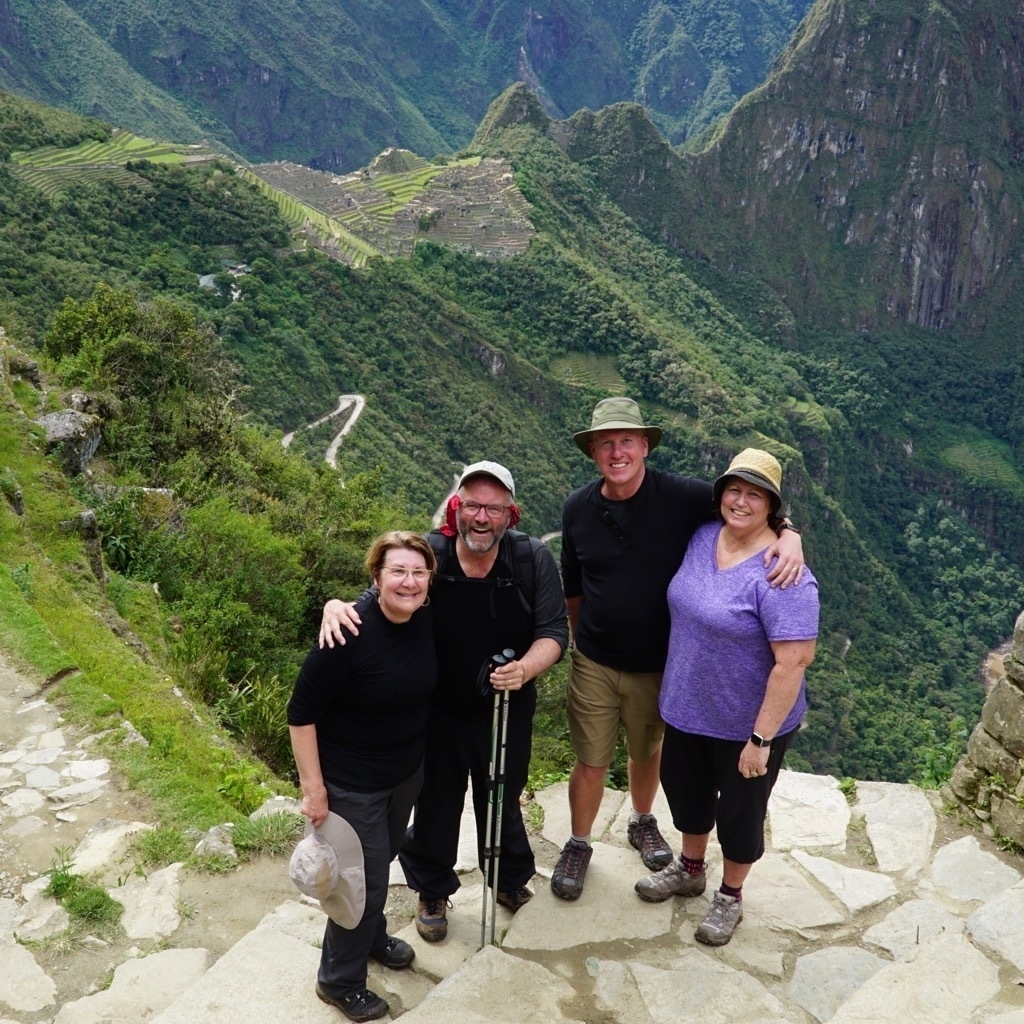
We discovered that we were staying at the same hotel that night, so we said our temporary good byes and we all headed down the final part of the trail. Along the way down we had our third big surprise. Jane was using her hiking poles and poked a viper. Our guide advised us to hurry on by and not pause to take any pictures of the poison snake. So we did.
When we arrived at the bottom we still had to take a bus further down the mountain to Agua Caliente and then a short walk to our hotel, the Inkaterra. At checkin we had the option of the 6:00 or the 8:00 seating for dinner. We thought that maybe a dip in the hot springs (Agua Caliente) would be a good way to relax and rest up for the 8:00 dinner. But by the time we had our complimentary Pisco Sour and chatted about our day with bob and Bonni, we decided that we didn’t have the energy to make it until 8:00. So we switched to the 6:00 seating and we are so glad we did. We were so tired and sore from our day of hiking that we were laying in bed reading by 8:00!
Tomorrow we go back to Machu Picchu to get an up close look!